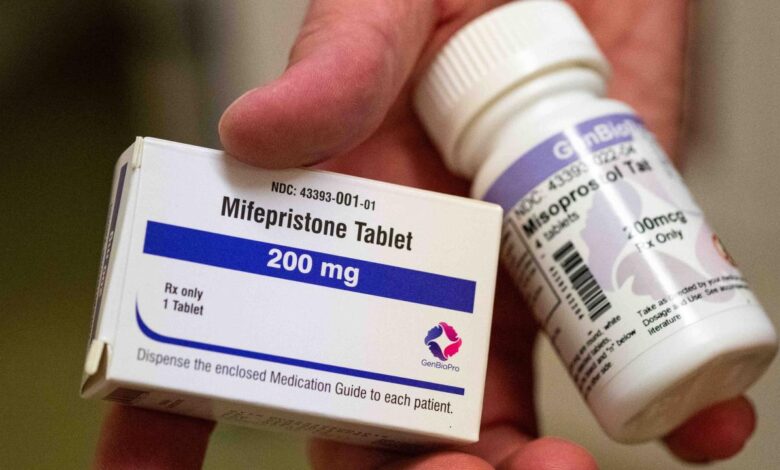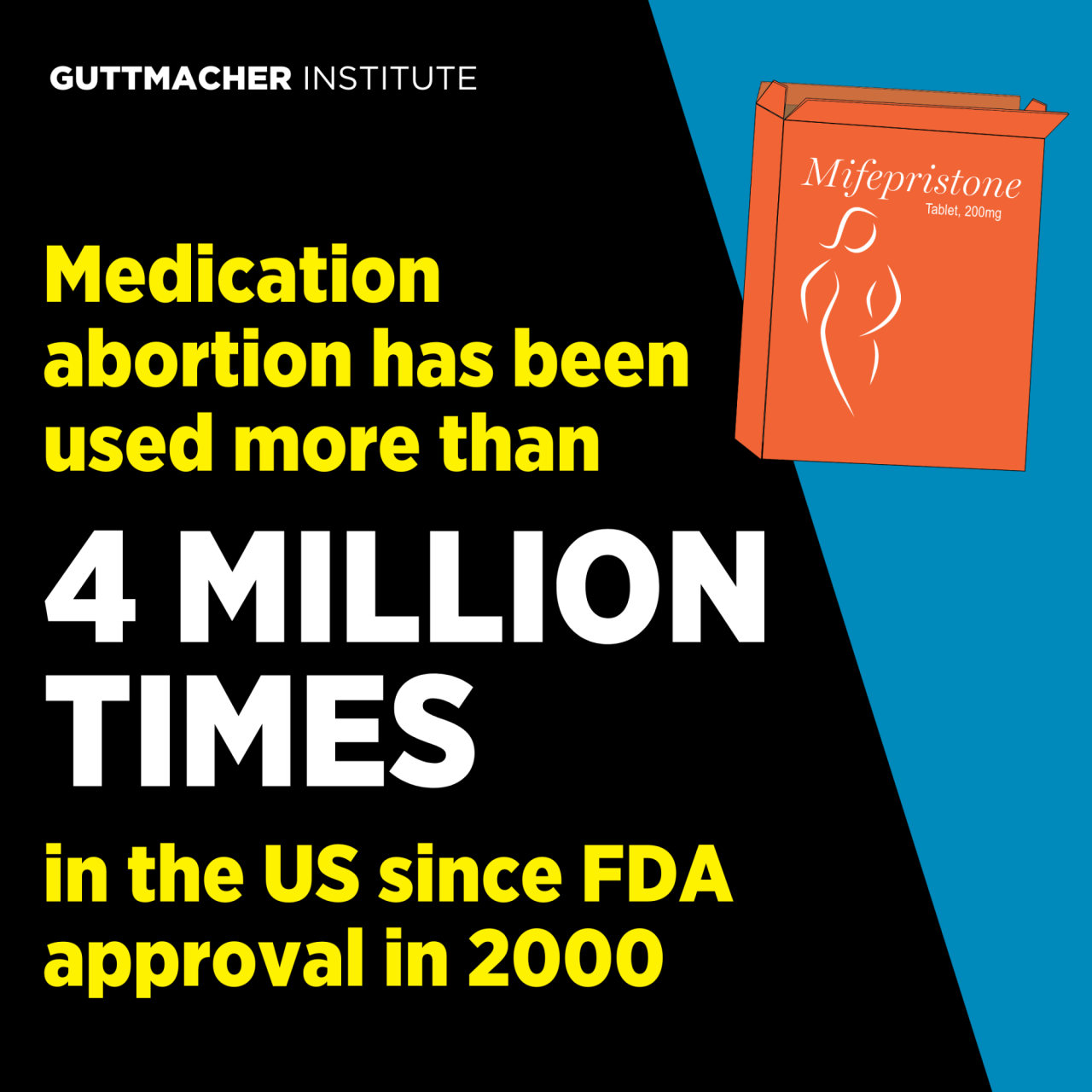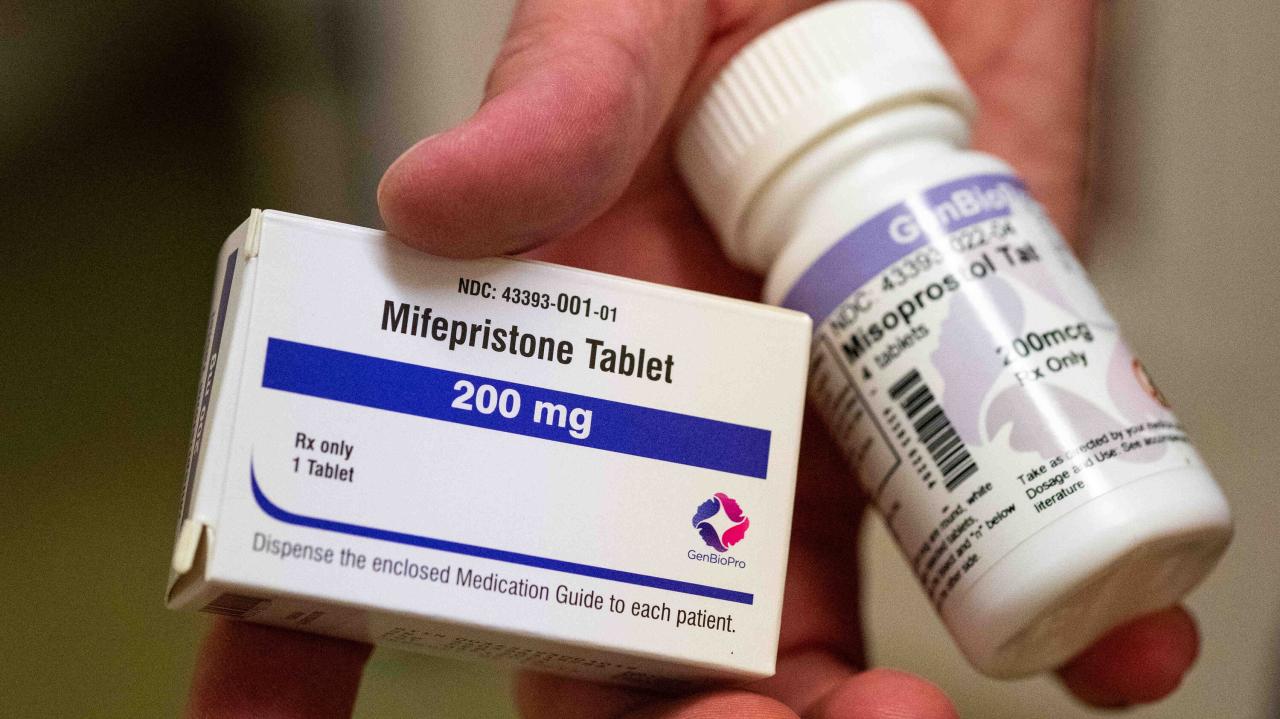
FDA decides to make medical abortions easier to get, opening up new avenues for reproductive healthcare access. This landmark decision has ignited a complex discussion about the balance between patient autonomy, healthcare access, and potential societal implications. Understanding the historical context, current regulations, and potential future impact is crucial to grasping the significance of this change.
The FDA’s decision to streamline the process for obtaining medical abortions involves changes to the required information, paperwork, and overall accessibility. This shift in policy could significantly impact the availability of these procedures and the experiences of patients seeking them. The potential implications for healthcare providers, logistical challenges, and public safety concerns also deserve careful consideration.
Background on Medical Abortions
Medical abortion, a safe and increasingly accessible method of terminating a pregnancy, has evolved significantly over the years. This method, relying on medication rather than surgical intervention, has become a vital option for individuals seeking to manage their reproductive health. This overview explores the historical context, regulatory framework, pharmacological aspects, and efficacy/safety considerations of medical abortion in the United States.
Historical Overview of Medical Abortion Procedures
Early attempts at medical abortion utilized various substances, often with unpredictable and potentially dangerous results. The development of mifepristone and misoprostol marked a significant advancement. These drugs, now widely used in medical abortion regimens, offer a more controlled and effective approach. The introduction of these medications revolutionized the landscape of abortion care, offering a non-surgical alternative.
Current Regulatory Landscape Surrounding Medical Abortions in the US
The legal and regulatory framework surrounding medical abortion in the US is complex and varies across states. Some states have enacted stricter regulations on the provision of medical abortion, while others maintain a more permissive approach. These regulations often address factors like gestational limits, required counseling, and physician qualifications. The ongoing legal battles and evolving interpretations of existing laws continue to shape the accessibility of medical abortion services.
Different Types of Medications Used in Medical Abortions
The primary medications used in medical abortions are mifepristone and misoprostol. Mifepristone, an anti-progesterone, blocks the hormone needed to maintain the pregnancy. Misoprostol, a prostaglandin analog, induces uterine contractions, facilitating the expulsion of the pregnancy tissue. These medications are typically administered in a specific sequence, tailored to the gestational age of the pregnancy.
Efficacy and Safety Profiles of Different Medical Abortion Regimens
Various regimens utilizing mifepristone and misoprostol have been developed and studied. Studies consistently demonstrate high efficacy and safety profiles for these regimens, particularly when used within the recommended gestational window. However, potential side effects, such as cramping and bleeding, are common and generally manageable. The efficacy and safety of different regimens vary slightly based on factors like the dose of each medication, and the gestational age of the pregnancy.
Stages of a Medical Abortion Process
| Stage | Medication | Administration Schedule | Description |
|---|---|---|---|
| Initial Consultation | None | Before medication administration | Comprehensive medical evaluation, including pregnancy confirmation and discussion of potential risks and benefits. |
| Mifepristone Administration | Mifepristone | Usually in a clinic setting, 24-48 hours before misoprostol. | Mifepristone blocks the hormone necessary to maintain the pregnancy. |
| Misoprostol Administration | Misoprostol | Usually 24-48 hours after mifepristone. Can be administered orally, vaginally, or buccally. | Misoprostol induces uterine contractions, facilitating the expulsion of the pregnancy tissue. |
| Follow-up Visit | None | Within a week of misoprostol administration. | Assessment of the completion of the abortion process and management of any potential complications. |
FDA’s Decision: Implications and Impact
The FDA’s recent decision to streamline the process for obtaining medical abortions has sparked considerable debate. This change promises to enhance access to this crucial healthcare option, but it also raises concerns about potential unintended consequences. Understanding the potential implications for patients, healthcare providers, and the broader public is vital to navigating this evolving landscape.This analysis delves into the anticipated effects of the FDA’s decision, examining potential benefits, drawbacks, and the broader societal implications of this significant policy shift.
It considers the impact on access, legal challenges, and the overall public health landscape, offering a comprehensive overview of the potential ramifications.
Potential Positive Outcomes
The FDA’s decision to ease access to medical abortion is expected to lead to several positive outcomes. Increased accessibility is likely to reduce barriers to care, particularly for individuals in underserved communities or those facing logistical challenges. This streamlining of the process may lead to more timely access to care, potentially reducing the need for later, more invasive procedures.
The FDA’s decision to streamline medical abortion access is a significant step forward. It’s interesting to consider how this might impact related healthcare initiatives, like the recent restructuring of JDRF following the pandemic. news jdrf restructures after pandemic highlights the ongoing need for adaptability and innovation in healthcare, mirroring the broader societal shifts impacting healthcare access.
Ultimately, easier access to medical abortions should improve healthcare outcomes for many individuals.
Furthermore, easier access could potentially result in improved maternal health outcomes by allowing for earlier interventions, particularly for individuals who may be experiencing complications.
Potential Negative Consequences for Stakeholders
Several stakeholders may experience negative consequences due to this decision. For some healthcare providers, the shift in procedure may necessitate adjustments to their practices and training. They might need additional resources or specialized training to handle the increased volume of medical abortions. Concerns regarding potential increases in unintended consequences or complications also exist. The transition could also create difficulties for those providers who conscientiously object to providing these services.
Anticipated Effects on Access to Medical Abortion Services
The FDA’s decision is expected to significantly impact access to medical abortion services. Increased accessibility should translate into a larger pool of individuals receiving this form of care. This may lead to a reduction in the reliance on surgical abortions, although that will depend on a variety of factors including access to healthcare facilities offering both options. It is crucial to monitor the impact of this change on access in different geographic areas to assess whether the anticipated increase in accessibility is indeed achieved.
Potential Legal Challenges or Responses to the FDA’s Decision
Legal challenges to the FDA’s decision are highly probable. Anti-abortion groups may challenge the decision based on various legal grounds, potentially delaying or obstructing implementation. These challenges will likely focus on the constitutionality of the decision and its alignment with existing legal precedents. This is expected to lead to court cases, which will impact how the decision is applied and implemented across different jurisdictions.
Potential Impact on Public Health and Policy
The FDA’s decision is likely to influence public health discourse and policy discussions surrounding reproductive healthcare. The implications for women’s health and autonomy will be a significant factor in the ongoing debate. This change will likely trigger new debates and discussions, possibly leading to further legislative actions at the state and federal levels.
Comparison of FDA’s Decision to Previous Regulations
| Aspect | Previous Regulations | FDA’s New Decision |
|---|---|---|
| Waiting Period | Often included a mandatory waiting period. | Eliminates or significantly shortens waiting periods. |
| In-Person Requirements | Often required in-person consultations. | May allow for telehealth consultations in some cases. |
| Provider Restrictions | May have restricted the providers who could prescribe the medication. | May broaden the scope of providers who can prescribe the medication. |
| Access to Information | May have limited the availability of information about the procedure. | May promote greater access to information about the procedure. |
Access and Availability of Medications
The FDA’s decision to ease access to medical abortion medications represents a significant shift in reproductive healthcare. However, ensuring widespread availability and appropriate distribution presents logistical challenges that must be carefully addressed. Effective implementation requires a multifaceted approach that considers the needs of both healthcare providers and patients.The successful rollout of these protocols hinges on a well-defined strategy for making the medications accessible.
This includes considerations for storage, transportation, and dispensing procedures, alongside robust training programs for healthcare professionals. Furthermore, patient education and counseling play a crucial role in empowering individuals to make informed decisions about their healthcare.
Potential Logistical Challenges
Ensuring consistent access to the medications across various geographic locations and healthcare settings will require careful planning. Rural areas often face challenges in maintaining adequate supplies and staffing. The medications may require specialized storage conditions to maintain their efficacy, posing additional logistical hurdles. The transportation and handling procedures must be robust enough to prevent damage or contamination of the medications during transit.
These logistical factors can significantly impact the accessibility of the medications, especially in underserved communities.
Strategies for Increasing Availability
Several strategies can enhance the availability of medical abortion medications. These include partnering with community health centers and pharmacies to establish convenient dispensing points. Collaborations with telehealth platforms can extend access to remote areas, reducing the need for in-person visits. The development of standardized supply chains, including secure storage and distribution networks, is also essential. Additionally, exploring alternative delivery methods, such as mail-order dispensing, can increase accessibility.
Impact on Healthcare Provider Training and Education
Healthcare providers will require comprehensive training on the new protocols and guidelines surrounding medical abortions. This training should cover the safe handling and administration of the medications, as well as the counseling and support needed for patients. Training programs should address potential complications and equip providers with the knowledge and resources to manage them effectively. Continuing medical education opportunities will also be vital to ensure providers remain updated on the latest developments and best practices.
Impact on Patient Education and Counseling Services
Comprehensive patient education and counseling are crucial components of medical abortion access. Patients need accurate information about the procedure, potential side effects, and post-abortion care. Counseling should address emotional concerns and provide support during the entire process. Healthcare providers must be equipped to address the diverse needs of patients and provide culturally sensitive care. Patient education materials should be readily available in various languages and formats.
Summary of Distribution Channels
| Distribution Channel | Description | Advantages | Disadvantages |
|---|---|---|---|
| Community Health Centers | Medication dispensed through established healthcare facilities in local communities. | Accessible to patients within the community, reduces travel time. | May have limited capacity, and location constraints. |
| Pharmacies | Medication dispensed through retail pharmacies, increasing accessibility. | Widely available and convenient for patients. | Potential for stigma or judgment from staff, lack of privacy. |
| Telehealth Platforms | Remote access to medical abortion information and prescriptions. | Increases access to patients in rural areas, convenient scheduling. | Requires reliable internet access and technology proficiency from patients. |
| Mail-Order Dispensing | Medication delivered directly to patients’ homes via mail. | Convenient for patients who cannot or prefer not to travel to a clinic. | Requires careful security protocols and potential delays in receiving medication. |
Public Health and Safety Considerations
Making medical abortion more accessible is a significant step, but it’s crucial to address potential safety concerns and ensure patient well-being. A comprehensive approach that prioritizes post-abortion care, mitigates potential risks, and anticipates the impact on the healthcare system is essential. This necessitates a robust framework for managing potential adverse events and providing accessible, high-quality care to all individuals seeking this option.
Strategies to Mitigate Safety Concerns
A multi-faceted approach to minimizing risks is vital. This includes rigorous training for healthcare providers administering the medication, clear communication protocols for patients, and readily available resources for managing potential complications. Emphasis on patient education, especially regarding potential side effects and when to seek medical attention, is crucial. Implementing standardized protocols for managing adverse events will reduce variability in care and improve outcomes.
Importance of Post-Abortion Care and Follow-Up Services
Post-abortion care is integral to patient safety and well-being. It encompasses providing ongoing support, monitoring for potential complications, and addressing any emotional or psychological needs that may arise. Follow-up appointments allow for early detection of complications and ensure appropriate management. These services should be accessible and tailored to individual needs, including culturally sensitive support.
The FDA’s decision to streamline medical abortions is a huge step forward for reproductive healthcare. It’s exciting to see progress in this area, and it hopefully paves the way for more accessible options. This is great news for women’s health, but it’s also worth considering how advancements in other areas, like lab made skin cells might mean fewer experiments on animals , could also contribute to a healthier future.
Ultimately, the FDA’s decision reflects a wider push towards more efficient and humane healthcare practices.
Potential Impacts on Unintended Pregnancies and Maternal Health Outcomes
Increased access to medical abortion can potentially impact unintended pregnancies and maternal health outcomes in several ways. Improved access to safe and legal procedures can lead to fewer unsafe abortions and a decrease in maternal mortality rates. Comprehensive reproductive healthcare services, including counseling and support, are critical in addressing the broader context of unintended pregnancies and promoting informed decision-making.
This includes providing comprehensive resources for those experiencing an unintended pregnancy.
Potential Impacts on the Overall Healthcare System
The expansion of medical abortion access may necessitate adjustments within the healthcare system. This includes the need for additional training for healthcare providers, the development of appropriate infrastructure for managing potential complications, and the allocation of resources for post-abortion care. Collaboration between healthcare providers, policymakers, and community organizations is crucial to ensure a smooth transition.
Strategies for Managing Potential Adverse Events
Robust protocols are necessary for managing potential adverse events associated with medical abortion. These protocols should include clear guidelines for recognizing and treating complications, readily available resources for patients to contact healthcare providers if needed, and access to emergency care when necessary. Effective communication between healthcare providers and patients is key in managing these events.
The FDA’s decision to streamline medical abortion access is a huge step forward. It’s a positive change for so many, but it also reminds us that taking care of our bodies, both physically and emotionally, is crucial. Learning how to exercise like an Olympian with this insider knowledge exercise like an olympian with this insider knowledge can be a great way to support overall well-being, and hopefully, this new accessibility will make a real difference in people’s lives.
Table of Potential Side Effects
This table provides a general overview of potential side effects from different medical abortion protocols. Note that individual experiences may vary.
| Protocol | Frequency (Estimated) | Types of Side Effects |
|---|---|---|
| Medication A (mifepristone + misoprostol) | Common: nausea, vomiting, diarrhea, abdominal pain; Uncommon: heavy bleeding, fever, infection | Nausea, vomiting, diarrhea, abdominal pain, cramping, fever, heavy bleeding, chills, infection, headache, dizziness |
| Medication B (misoprostol alone) | Common: cramping, diarrhea, nausea; Uncommon: heavy bleeding, fever, infection | Cramping, diarrhea, nausea, vomiting, fever, chills, heavy bleeding, infection, headache, dizziness |
| Medication C (other methods) | Variable based on the specific method | Consult with a healthcare professional for details on specific protocols |
Societal and Ethical Implications

The FDA’s decision to streamline the process for obtaining medical abortions has ignited a fervent debate across society, touching upon deeply held beliefs about women’s health, reproductive rights, and the role of government in personal healthcare choices. This decision has broad implications, impacting not only individual women but also healthcare providers, policymakers, and the wider community.The decision highlights the complex interplay between access to healthcare, ethical considerations, and societal values.
The ease of access to medical abortions, while potentially empowering women, also raises concerns about potential misuse and its impact on societal views of pregnancy and childbirth. Examining diverse perspectives, analyzing the arguments for and against, and exploring the ethical considerations are crucial in understanding the full scope of this issue.
Potential Societal Impact
The decision to make medical abortions easier to access is expected to have a profound effect on various societal sectors. It may influence future policies related to healthcare access and potentially shift the cultural dialogue surrounding reproductive choices. The availability of medical abortions could affect family planning decisions and potentially impact birth rates.
Arguments For and Against
Advocates for easier access to medical abortions often emphasize the importance of bodily autonomy and the right of women to make decisions about their own reproductive health. They highlight potential improvements in women’s health outcomes and reduced reliance on potentially unsafe procedures.Conversely, opponents often cite concerns about the moral status of a fetus and the potential for increased abortion rates.
They argue for the protection of fetal life and the importance of alternatives such as adoption. The potential for increased access to abortion has implications for various sectors of society, including healthcare, families, and the community.
Ethical Considerations, Fda decides to make medical abortions easier to get
The FDA’s decision raises several complex ethical questions. These considerations center around the balance between a woman’s right to make choices about her body and the moral status of a developing fetus. The definition of personhood, the beginning of life, and the role of government in regulating medical procedures are central to this debate.
“The debate surrounding abortion is deeply rooted in differing moral and ethical frameworks. There is no universally agreed-upon definition of when life begins, and this ambiguity often fuels the conflict between the rights of the pregnant person and the potential for life.”
Comparative Analysis of Viewpoints
Different viewpoints on abortion access reflect diverse moral and religious beliefs, philosophical perspectives, and societal values. Pro-choice advocates typically emphasize a woman’s autonomy and the right to control her own body. Pro-life advocates, conversely, stress the moral status of the fetus and advocate for its protection. A neutral observer can see that both sides present valid arguments.
Impact on Women’s Health and Reproductive Rights
The decision to ease access to medical abortions could significantly improve women’s health outcomes by increasing access to safe and legal procedures. Reduced reliance on potentially unsafe methods could decrease complications and mortality rates associated with unsafe abortions. Improved access to medical abortions could positively impact women’s reproductive rights, promoting greater control over their reproductive health.
Potential Impact on Healthcare Providers: Fda Decides To Make Medical Abortions Easier To Get
The FDA’s decision to streamline the process for obtaining medical abortion medications will undoubtedly reshape the landscape of healthcare delivery. This shift presents both opportunities and challenges for providers, demanding adjustments in training, infrastructure, and overall workflow. Providers must adapt to the new regulatory environment to ensure patient safety and access to care.The change in access to medical abortion will impact healthcare providers across various specializations.
From primary care physicians to OB/GYNs, family planning clinics, and even some urgent care centers, the responsibility and protocols for administering these medications will likely be expanded. This requires a thorough understanding of the updated guidelines and a commitment to ensuring equitable access.
Training and Education Adjustments
The FDA’s decision necessitates a comprehensive update to the training and educational resources available to healthcare providers. Existing curricula will need to incorporate the new guidelines for prescribing and administering these medications, including updated dosages, potential side effects, and management strategies. This will require ongoing professional development opportunities, likely including webinars, workshops, and potentially even dedicated online modules.
Medical schools and residency programs must also adapt their curricula to incorporate the latest advancements in medical abortion protocols.
Facility Infrastructure and Procedural Adjustments
Healthcare facilities will need to adjust their infrastructure and procedures to accommodate the increased use of medical abortion medications. This may involve dedicated consultation rooms, updated storage protocols for medications, and adjustments to patient intake processes. Facilities may also need to invest in additional supplies and equipment to manage potential complications, ensuring that the necessary support is available for patients.
For example, hospitals with emergency departments may need to ensure appropriate staff training and emergency protocols are in place.
Workload and Resource Impact
The increased access to medical abortion could potentially lead to an increase in patient volume for some healthcare providers. This increase may strain existing resources and require adjustments to scheduling, staffing, and overall workflow. Providers will need to proactively address potential resource limitations to ensure timely access to care and avoid compromising patient safety. This will be particularly crucial in underserved communities where access to healthcare may already be limited.
Changes to Medical Practices Regarding Medical Abortion
Medical practices will need to adapt their existing protocols for medical abortions to align with the new FDA guidelines. This will necessitate revisions to patient counseling and informed consent procedures, as well as updated guidelines for managing potential complications. The updated guidelines will also likely result in more patient-centered care, allowing for more flexibility and choice in how medical abortions are administered.
For instance, telemedicine consultations may become more prevalent for initial assessments and follow-up care.
Responsibilities of Healthcare Providers in the New Framework
| Responsibility | Description |
|---|---|
| Patient Counseling and Informed Consent | Providers must thoroughly counsel patients about the procedure, potential risks and benefits, and alternatives to ensure fully informed consent. |
| Medication Administration | Providers are responsible for administering the medications according to the updated guidelines, monitoring patients for side effects, and managing potential complications. |
| Follow-up Care | Ensuring appropriate follow-up care for patients, including monitoring for complications and addressing any concerns, is a crucial responsibility. |
| Emergency Preparedness | Healthcare facilities must have protocols in place for managing potential complications, including emergency situations and patient safety. |
| Referral and Collaboration | If necessary, providers should be able to refer patients to specialists or other healthcare providers as needed. |
Final Summary

The FDA’s decision to make medical abortions easier to get has sparked a nationwide debate, touching on personal autonomy, public health, and ethical considerations. While proponents highlight increased access and patient choice, opponents raise concerns about potential safety risks and societal impacts. Navigating these complex issues requires a nuanced understanding of the various perspectives and potential consequences.




